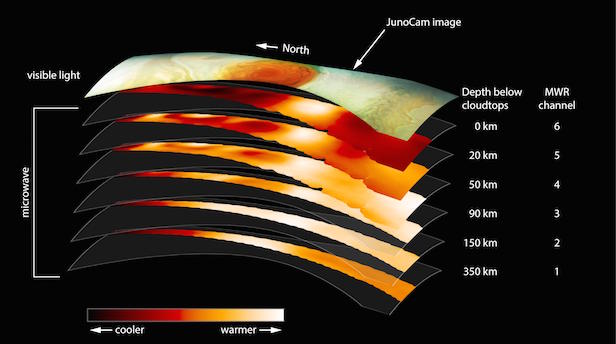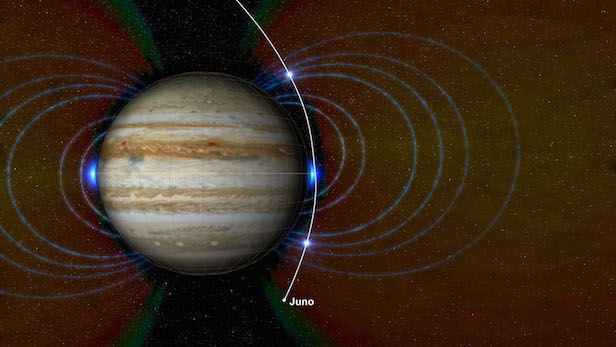Great Red Spot’s roots lie deep in Jupiter’s foundations
NASA’s Juno spacecraft has peered through the clouds of the gas giant to reveal more detail about the planet’s famous storm

Juno’s MWR instrument can split up the different layers of Jupiter’s atmosphere to see how far down the GRS exists. Image credit: NASA/JPL-Caltech/SwRI
The weird and wonderful nature of Jupiter keeps bringing us new surprises, as the NASA spacecraft, Juno, continues on it’s journey over the gas giant’s cloud tops. This time, the spacecraft has revealed that the famous cloud-top feature, the Great Red Spot (GRS), on Jupiter penetrates far below the cloud tops. Not only that, but there are two new radiation zones that had been unexplored prior to the mission.
This news was announced recently at the annual American Geophysical Union meeting in New Orleans. Juno has many science instruments onboard, but the one responsible for uncovering the true depth of the GRS is the Microwave Radiometer (MWR). “Juno’s Microwave Radiometer has the unique capability to peer deep below Jupiter’s clouds,” says Michael Janssen, Juno co-investigator from NASA’s Jet Propulsion Laboratory (JPL) in Pasadena, California. “It is proving to be an excellent instrument to help us get to the bottom of what makes the Great Red Spot so great.”
“One of the most basic questions about Jupiter’s Great Red Spot is: how deep are the roots?” says Scott Bolton, Juno’s principal investigator from the Southwest Research Institute in San Antonio. “Juno data indicate that the solar system’s most famous storm is almost one-and-a-half Earths wide, and has roots that penetrate about 300 kilometres (200 miles) into the planet’s atmosphere.”
Jupiter’s GRS has been the most prominent feature on the face of Jupiter for centuries. Even an amateur astronomer can observe it, as this giant storm of crimson-coloured clouds sits evident in the southern hemisphere. The enormous storm travels counter clockwise around the perimeter of the oval, and its speeds are greater than any storm on Earth. As of 3 April 2017, the GRS has a width of 16,000 kilometres (10,000 miles), which is 1.3 times the diameter of Earth.
This has not always been the case however, as it’s been noticeably observable since 1830 and because of this, the storm has previously been seen to be much larger. In 1979, as the two NASA spacecrafts Voyager 1 and 2 flew by Jupiter whilst on their way to interstellar space. At this point, the GRS was measured to be twice the size of Earth. Today’s measurements using Earth-based telescopes have now shown that the tempestuous feature within Jupiter has decreased in width by one-third and height by one-eighth since Voyager’s observations. This brings up some interesting questions regarding the storm’s future.

The new radiation zone is located just above Jupiter’s atmosphere near the equator. Also marked at the regions of high-energy, heavy ions observed at high latitudes. Image credit: NASA/JPL-Caltech/SwRI/JHUAPL
“Juno found that the Great Red Spot’s roots go 50- to 100-times deeper than Earth’s oceans and are warmer at the base than they are at the top,” says Andy Ingersoll, professor of planetary science at Caltech and a Juno co-investigator. “Winds are associated with differences in temperature, and the warmth of the spot’s base explains the ferocious winds we see at the top of the atmosphere.”
A new radiation zone was also detected just above Jupiter’s atmosphere, near the equator. This zone consists of many hydrogen, oxygen and sulphur ions – an atom or molecule that has lost at least one electron – travelling at speeds close to the speed of light. This revelation was made by Juno’s Jupiter Energetic Particle Detector Instrument (JEDI) investigation. Scientists have suggested that the particles originate from energetic neutral atoms (fast moving ions with no electric charge) created in the gas around the Jovian moons Io and Europa. These neutral atoms then become ions when the intense radiation with Jupiter’s upper atmosphere strips away when of their electrons.
“The closer you get to Jupiter, the weirder it gets,” says Heidi Becker, Juno’s radiation monitoring investigation lead at JPL. “We knew the radiation would probably surprise us, but we didn’t think we’d find a new radiation zone that close to the planet. We only found it because Juno’s unique orbit around Jupiter allows it to get really close to the cloud tops during science collection flybys, and we literally flew through it.”
Juno also detected the signatures of high-energy heavy ions within the edges of Jupiter’s relativistic electron radiation belt; this region is abundant in electrons travelling close to the speed of light. These signatures, observed during Juno’s high altitude encounters with the electron belt, were detected by Juno’s Stellar Reference Unit (SRU-1) star camera. A spacecraft has never explored this region, and the origin and exact species of these particles continue to remain elusive.
Keep up to date with the latest reviews in All About Space – available every month for just £4.99. Alternatively you can subscribe here and make the most of our Christmas offer for a fraction of the price!




